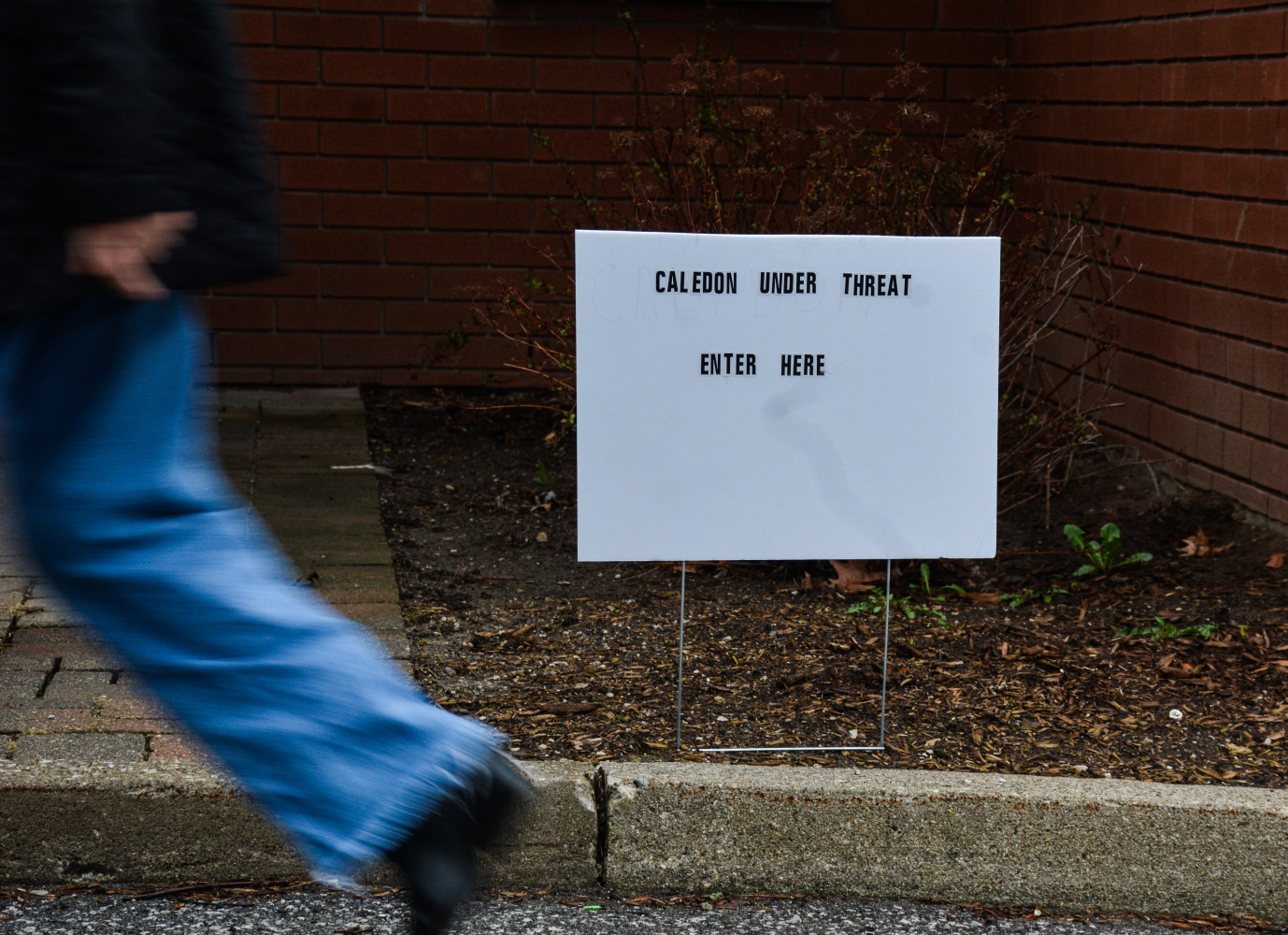
Despite opposition from Queen’s Park & Peel Region, Caledon Mayor Annette Groves doubles down on scheme to develop 35K homes
Annette Groves says she wants to listen.
After an unprecedented number of Caledon residents filled almost every floor of Town Hall, the Mayor—elected in 2022 on a progressive agenda to protect the environment and shift away from developer-led planning—claimed she will not move forward with her snap plan, revealed out of nowhere about a month ago, to approve 35,000 new homes until the public is fully informed.
She has previously said planning is a public process that must not be shaped by developers.
Last week, facing widespread public backlash and revelations that the provincial and regional government told her the surprise plan does not conform with overriding policies, she backed down, removing 12 bylaws to amend zoning for 12 parcels of land which she was set to approve Tuesday, April 30th after first putting the unannounced scheme on a council agenda at the end of March claiming her strong mayor powers allowed her to circumvent the usual public planning process.
The backlash was swift, and deep.

Mayor Annette Groves defending her controversial plan during a public meeting attended by approximately 150 residents.
(Joel Wittnebel/The Pointer Files)
She finally relented last week and claimed the Town must first provide all the information necessary for the public to understand the need for the 12 zoning amendments before triggering the construction of 35,000 homes, the largest development plan in Caledon’s history.
But it appears, despite the position of Queen’s Park and the Region which have authority over growth in Peel, she is pushing forward without listening to residents, not using her own planning staff, instead using her strong mayor powers and working with external consultants and lawyers representing some of the same developers who stand to gain from the scheme.
Groves launched a new page on the Town’s website Friday dedicated to her zoning amendments, highlighting what she intends to do, regardless of any opposition.
The Mayor, despite repeated claims that the backlash has shown her proper communication is essential to ensure public trust, repeats the same misleading claims about the massive development scheme on the Town’s new webpage.
She continues to ignore questions about how the development plan was initiated. She has not explained the need for a rushed process which the Region of Peel has ripped apart as “premature”, or how she can move forward after Housing Minister Paul Calandra wrote Groves a letter last week detailing the non-conformity with provincial legislation and policy governing the use of land in the approved 413 Highway corridor.
The webpage includes a list of Frequently Asked Questions. Despite being published on the Town’s website, a public resource paid for by Caledon taxpayers, the answers to these questions push the developer-friendly political agenda of the embattled mayor.
The newly published information makes repeated mentions of the housing crisis and how the plan being pushed by Groves is a proactive measure to tackle it. The Region of Peel analyzed each of the 12 zoning amendments aggressively supported by Groves and written by development lawyer Quinto Annibale with the firm Loopstra Nixon.
The upper-tier regional government concluded the majority of the 12 parcels are not required for Caledon to achieve its housing pledge to the Ontario government; the zoning bylaws have no language to guarantee affordable housing; and there are no restrictions to ensure the type of construction needed to address the housing crisis.
Mayor Groves has also repeatedly stressed these zoning amendments will “foster sustainable growth in the community”.
As currently written, the Mayor’s zoning bylaws include nothing that prohibits developers from building any type of housing they choose. There are no requirements for secondary planning, affordable housing, or any specific housing types. The zoning would also allow each developer to pave the vast majority of the site, according to the Region of Peel. This would create significant flood risks, and increase risks from more frequent storms and heat-related impacts caused by climate change.
Ian Sinclair, a longtime resident of Caledon and former councillor, stated at last week’s packed public meeting that each of the 12 zoning amendments reads like a blank cheque for the development industry, allowing companies to build whatever type of housing they choose.
Groves has given them “just about every zoning permission imaginable … including a few kitchen sinks,” he said. “And it looks like developers could write their own tickets because of that.”
Groves claims the subject lands are already identified in the Town’s draft Growth management plan. What she fails to mention is that the Region has still not approved this plan.
“To date, the Region has not found the GMPP satisfactory, nor does it reflect the requirements of the phasing plan and the outcomes of the identified opportunities and constraints.”
The Region also pointed out that many of the 12 zoning amendment bylaws Groves planned to approve on Tuesday violate Caledon’s own planning policies and include lands that are not even within the expanded urban boundary.
The statement on the webpage launched Friday, May 3, that these lands were identified for zoning amendments because they are in areas where “existing or planned infrastructure can support development” is deeply misleading. According to the reports from the Region of Peel—which Groves and CAO Nathan Hyde refuse to release to the public (despite specific direction from the Region to do so; they are not included on the new webpage)—many of the 12 parcels do not have sufficient infrastructure to support growth at this scale.
“A significant concern of the Region’s is that there is insufficient capacity in the Region water and wastewater systems…to accommodate this proposed community at this time,” the region states in the report on one of the 12 amendments. Similar issues with a lack of existing infrastructure to support the proposed developments exist in almost all of the 12 parcels Groves is trying to get developed. “Significant upgrades and additional watermains and sanitary sewers are required to service this community both in the local vicinity of this developer and within the entire water and wastewater system.”
This will require “multi-year” design and construction efforts, the Region states, estimating a cost of $6.2 billion for water and $6.7 billion for wastewater to service just the 13,000 units mandated by the PC government for Caledon to address housing needs. Groves is trying to push through 35,000 homes.
The Region pointed out that no financial analysis has been done to determine how tens of billions of dollars will be paid for to provide all the necessary infrastructure and services, putting taxpayers and the Town in significant risk. Many of the land parcels Groves wants developed do not currently have surrounding infrastructure, ignoring planning policy that promotes growth in and around areas where water mains, storm water systems, sanitary infrastructure, other utilities, roads, libraries, community centres, police stations, fire services, paramedic services, public health infrastructure, transit, schools, hospitals and a range of other services and infrastructure already exist.
Groves has refused to explain why she has recklessly abandoned basic principles of responsible planning, trying to force growth where it is not supported.
As currently written, there is nothing in the zoning amendments to ensure lands are set aside for things like regional services, public health or emergency services—critical features of complete communities.
As stated, there are currently no holding provisions in the existing bylaws to require developers to construct a range of housing types. Groves has “directed” that zoning permissions be added, but this is meaningless if the bylaw does not require a range of housing types. The same goes for secondary planning and other critical studies to ensure the environment and farmland are protected.
As the Region states, Town staff “intend” on requiring secondary planning, but this is not expressed in the bylaw.
It is unclear why, if Groves wants these crucial features going forward, as she is now claiming, they were not simply written into her bylaws in the first place. If they are approved as currently written the public would have no way to shape the design for 35,000 new homes, leaving the future of Caledon in the hands of developers.
The statement above is blatantly false. The use of strong mayor powers to force through these zoning changes has never been done before in Ontario by any other mayor. Groves’ approach has completely disregarded the “standard planning process”.
Victor Doyle, an urban planning expert who designed the legislation that created the Greenbelt, says in his decades of planning experience, he has never seen anything like this plan before.
Describing the mayor’s actions as simply “unprecedented direction” is a spin that deflects from what several residents have described to her face in public meetings over the last two weeks as her “anti-democratic” conduct.
The Town has scheduled a series of public information sessions to provide further information about these 12 zoning amendments. They will occur on Wednesday, May 15 from 7-9 p.m. at Southfields Community Centre (225 Dougall Ave); Thursday, May 23 from 7-9 p.m. at Albion Bolton Community Centre (150 Queen St. S); and Monday, June 10 from 7-9 p.m. at Caledon East Community Centre (6215 Old Church Rd.).
The same information on the webpage will be presented at each session through a presentation from Town staff.
Email: [email protected]
Phone: 437-922-9889
At a time when vital public information is needed by everyone, The Pointer has taken down our paywall on all stories to ensure every resident of Brampton, Mississauga and Niagara has access to the facts. For those who are able, we encourage you to consider a subscription. This will help us report on important public interest issues the community needs to know about now more than ever. You can register for a 30-day free trial HERE. Thereafter, The Pointer will charge $10 a month and you can cancel any time right on the website. Thank you
Submit a correction about this story


